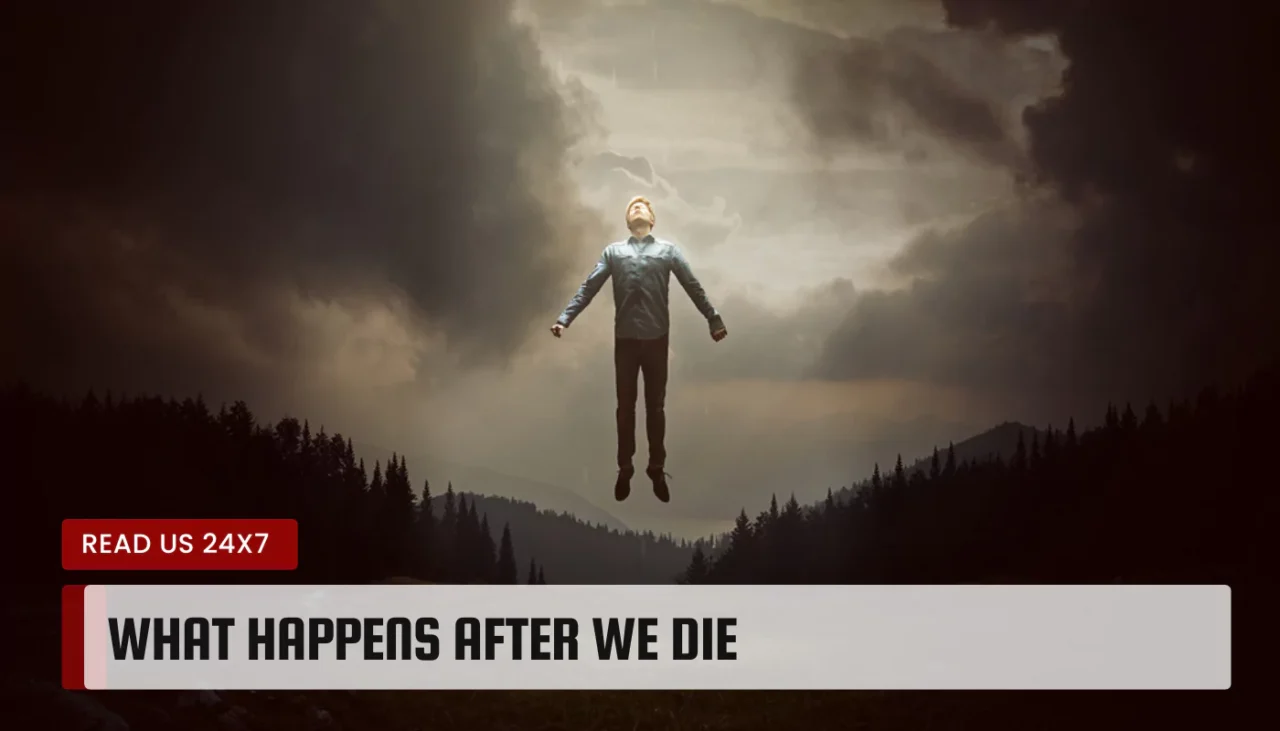Many people wonder what happens after we die. Death comes when the body stops working, with no more heartbeat or breath. Our blog breaks down this mysterious journey, from physical changes to coping with loss.
Get ready for a clear guide on life’s final chapter.
What Happens Physically When You Die?
When a person dies, the spirit separates from the body, and physical changes start to occur. The body undergoes cooling and various visible changes in skin and nails.
Separation of spirit and body
The moment someone dies, their spirit and body part ways. This separation marks the end of physical existence and the beginning of a transition beyond our understanding. Death signals this departure, where breath ceases and life as we know it concludes.
It’s a profound transformation that happens to every living being.
Following this separation, the body begins to undergo noticeable changes. These include relaxation of muscles, cooling down, and blood pooling in certain areas due to gravity. Each step is natural and follows a predetermined path leading up to what comes after death: Changes in the body.
Changes in the body
After the spirit separates from the body, a series of physical changes begin to take place. Weight and muscle loss occur as the body starts to break down. This is a natural part of the process where vital signs also show a decline or become irregular.
Breathing patterns may change, indicating that death is near. These shifts signal the irreversible journey towards death, marking an end to all biological functions.
Post-death, the body goes through further transformations including muscle relaxation followed by stiffness known as rigor mortis. The temperature of the deceased’s body drops as it begins to cool down, aligning with ambient temperature over time.
Blood pools in certain areas due to gravity, creating discoloration while organs cease functioning altogether. Eventually, stiffening relents as the final phase of decomposition sets in, marking significant postmortem changes in the body.
What Happens at the Moment of Death?
At the moment of death, heart and lung function cease, while brain activity stops.
Cessation of heart and lung function
Lungs often stop functioning before the heart fully ceases its activity, signaling a critical phase in the process of dying. This sequence marks the onset of respiratory failure followed by cardiac arrest, a condition known as cardiopulmonary failure.
The stopping of these vital functions indicates that biological death is imminent, marking a key moment in the end-of-life phenomenon.
Clinical death occurs once there is a complete halt in heart and lung function, rendering all vital signs absent. This terminal event signifies organ shutdown and constitutes the ultimate cessation of life, transitioning an individual from being to not-being within moments.
Terminal event guidance suggests this stage reflects not just the end but also initiates subsequent changes within the body post-mortem.
Brain activity stops
Brain activity stops at the moment of death. The cessation of brain function occurs, leading to the end of neurological activity and the shutdown of cerebral processes. This results in the absence of brain waves, loss of cognitive function, and termination of mental processes.
Although it’s important to note that the brain may continue to work for up to 10 minutes after death, criteria for declaring death include the absence of brain activity as different organs shut down at varying rates toward the end of life, with the brain being one of the last to stop functioning.
What Happens After Death?
After death, the body begins to cool, and changes occur in the skin and nails. Internal organs cease functioning.
Cooling of the body
As the body cools after death, it becomes pale as blood drains from the skin’s smaller veins. This process continues until the body temperature matches that of the surrounding air (algor mortis).
Following this, all muscles stiffen in a phenomenon known as rigor mortis, impacting various areas of the body. Finally, muscles start to relax due to chemical changes in cells and internal tissue decay (secondary flaccidity), leading to postmortem muscle relaxation.
Once the heart stops beating and breathing ceases, this sequence of changes begins to take place in a relatively predictable manner. The cooling off of the body is one of several postmortem processes that occur after death.
Changes in skin and nails
After death, the body undergoes a series of changes that affect the skin and nails. Muscle stiffening, known as rigor mortis, begins within a few hours and can last up to 48 hours.
As different organs shut down at various rates, livor mortis causes the skin to appear discolored due to blood pooling. Meanwhile, algor mortis results in a drop in body temperature.
These postmortem alterations can significantly impact the appearance of the skin and nails during the process of decomposition.
Functioning of internal organs
The functioning of internal organs ceases as death occurs. Vital signs decline or become irregular, signaling the body’s decline before death from chronic illnesses or natural causes.
As the body’s physiological changes progress, vital organ failure becomes inevitable.
Decline in vital signs and irregular vital functions are clear indicators of the impending cessation of internal organ function. The impact of chronic illness on bodily functions further contributes to the deterioration of vital functions preceding death.
This progression is a natural part of the body’s response to an impending end-of-life event.
Coping with Grief and Loss
Coping with grief and loss involves seeking support from loved ones, mental health professionals, or support groups. Understanding the process of dying and the various types of grief can aid in navigating through this challenging time.
Resources and support for those grieving
After the loss of a loved one, it is crucial to find sources of support and comfort. Here are some avenues for finding such resources:
- Bereavement support groups: Joining a support group that has experienced similar losses can provide a sense of community and understanding.
- Grief counseling: Seeking professional help from therapists or counselors specializing in grief can assist in navigating the complex emotions associated with loss.
- Mourning rituals: Many find solace in observing cultural or personal mourning rituals to honor their loved ones’ memory.
- Spiritual guidance: Turning to religious or spiritual leaders for guidance and comfort often provides strength during difficult times.
- End-of-life care resources: Hospice professionals can offer invaluable support during the terminal illness and bereavement process, ensuring comfort for both the dying and their families.
- Bereavement therapy: Engaging in therapy specifically tailored towards coping with bereavement can be immensely beneficial.
- Religious community involvement: Active participation in religious communities often provides solace and support through shared beliefs and practices.
- Coping strategies education: Learning various coping strategies from books, online resources, or seminars can aid individuals in managing their grief effectively.
- Utilizing bereavement services: Leveraging available services designed to enhance coping skills during the grieving process can provide valuable assistance.
- Building relationships with supportive individuals: Surrounding oneself with compassionate friends and family members who offer emotional support is crucial for managing grief effectively.
Understanding the dying process
As the dying process unfolds, bodily systems gradually shut down. Changes occur in vital functions before death from chronic illnesses or natural causes. These changes can include cessation of heart and lung function and stopping brain activity.
After death, the body undergoes a series of transformations such as muscle relaxation, a drop in temperature, blood pooling, stiffening, and eventual relaxation. Hospice care professionals are trained to ensure comfort and care for the dying during this time.
Understanding what dying looks like can help individuals face their own death or the passing of a loved one more preparedly and help them become more capable caregivers towards those reaching the end of life.
Different types of grief
Different types of grief exist: anticipatory grief, complicated grief, and disenfranchised grief. Anticipatory grief happens before the actual loss, such as when individuals foresee the death of a loved one due to illness or old age.
On the other hand, complicated grief is an extended and intense grieving process that may disrupt daily functioning and call for professional support. Disenfranchised grief occurs when the loss is not openly acknowledged or socially supported, like in cases of miscarriage or the death of a pet.
Each type of grief may demand varying coping strategies and support systems to navigate through the grieving process effectively.
Conclusion
As life ends, the body’s vital functions cease, including breathing, heartbeats, and brain activity. Changes in the body occur before death from chronic illnesses or natural causes.
Weight and muscle loss are common as the body breaks down before death. Vital signs decline or become irregular as death approaches. After death, the body undergoes a series of changes, including muscle relaxation, temperature drop, blood pooling, stiffening, and eventual relaxation.



